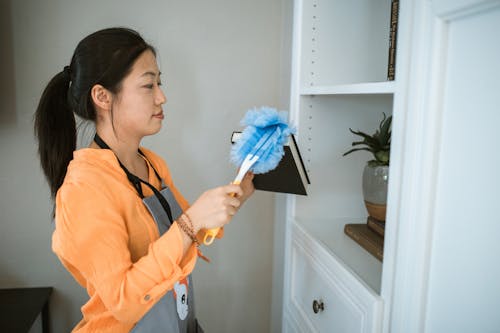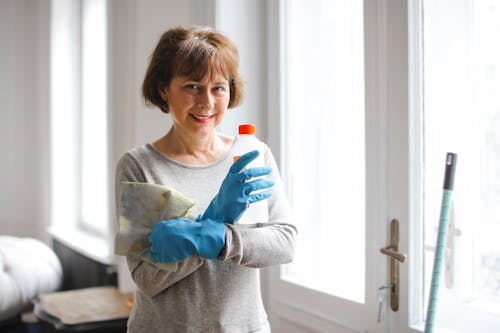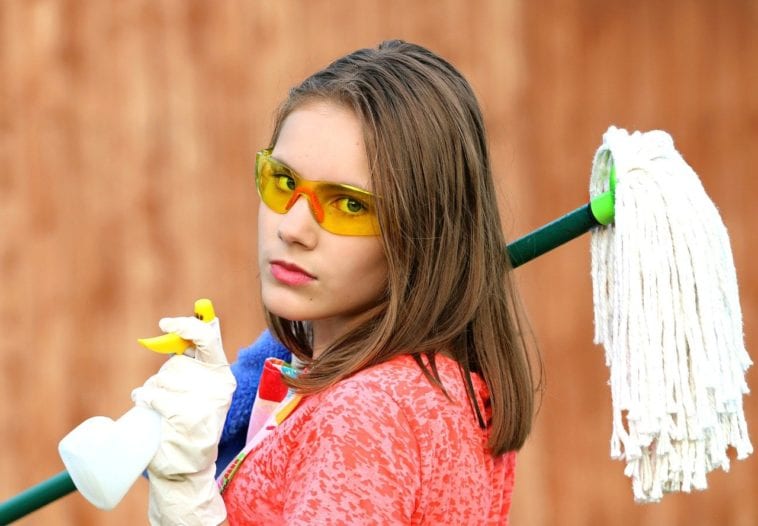Spring Cleaning is an essential part of any household.
Cleaning is a very important thing that we must do regularly to keep ourselves away from any bacteria and viruses especially in this time of the pandemic. In spring, the weather is warmer than the other season. This season is also said to be the season of trees to grow their leaves and the flowers also bloom. This is a season that most of us have vacancies and this could be our time to clean the entire house.

When we clean, we just usually sweep the floor and arrange the things that are unorganized especially if we are busy with our respective works. We do not tend to re-arrange or decorate our homes in different styles as we are already tired after work. It seems that we do not have enough time to clean our house. So most families reorganize and clean the entire house during the season of spring.
To help you clean up your home efficiently, I asked several lifestyle bloggers, cleaning experts, home industry insiders, realty experts, and environmental experts on how they do their deep cleaning. Learn from their insights and get inspired to do your own spring cleaning.
What is spring cleaning?
According to Ana Andres, Co-founder of TidyChoice, spring cleaning is the one time of the year that many people commit to deep cleaning their homes. A spring clean typically includes deep cleaning every room in the home and carrying all the little cleaning tasks that accumulated during winter.
Melanie Musson, a home safety expert with ExpertInsuranceReviews, also says that spring cleaning is a deep cleaning that addresses big and small projects that are either neglected during the rest of the year or don’t need to be accomplished regularly.
For John Linden, an interior designer from Los Angeles and Lead Designer of MirrorCoop, spring cleaning, also known as cleaning out the clutter, involves getting rid of unwanted stuff and clutter through a series of stages. Following these steps will help you get your space in order for the warm weather.

For John Bodrozic, Co-Founder of HomeZada, spring cleaning is the process of performing recurring preventative maintenance and cleaning tasks inside and outside your home. It is also repairing any small things that need to be fixed. In addition, there are a number of deep cleaning tasks that are usually done once a year that you need to tackle.
Then Holly Berrigan, Founder of Eco Modern Shop & MYSA Natural Wine, added that spring cleaning is an opportunity to refresh your home and transform it from a winter den to a fresh new space. The part in this that, I think, is really important for the Zero Waste community to remember in this is that it does not mean we need to have a lot of new things to accomplish it.
Why is spring cleaning necessary?
Opportunity to start fresh with spring
Every spring after a long winter, says Sarah Stromsdorfer, the founder of Tamborasi, people have often been accumulating various items and clothing in their house, possibly trash, dust, and more. When spring arrives, it is an opportunity to start fresh which is exactly what spring has always represented in spirit. It is also a little warmer outside which makes it easier to open all the doors of your house to get fresh air in, and maybe even gather old items for a garage sale.

Mental peace
Abe Navas, the General Manager of Emily’s Maids, a house cleaning service in Dallas, Texas, says, “Your living space has a life of its own. You move around objects, you bring dust, dust enters from windows and doors. Wear and tear create a microcosmos inside your home. If you cook, there are a million factors of why your home gets dirty, and why you should clean it. The biggest one for me is mental peace, seeing my home tidy up gives me peace and tranquility, that even if the outside world is a mess, my home is right for me.”
Improve Health
Ana Andres also said that during winter, we tend to keep our windows closed and our homes don’t get aired out as much as they should. It’s not good for our health to be breathing in all the dust that gathers within the home. Also, a deep clean can do wonders for our mental health which is particularly beneficial in getting over the winter blues.
Improves Air Quality and Overall Mood
Melanie Musson says, Spring cleaning gets people inspired to deeply clean areas that may
have been ignored through the rest of the year. A clean house is proven to have improved air quality, which is better for health. Spring cleaning can also help boost mood because it leads to a sense of accomplishment.
Keep Home Safe And In Efficient Operations
According to John Bodrozic, spring cleaning is necessary for a few reasons including the need to keep your home and its equipment, appliances and building materials operating efficiently. Spring cleaning is also important to keep your family living in a healthy home that prevents people from getting sick due to bad air, water, and temperature quality. Another reason spring cleaning is important is to keep your family safe by preventing fire, smoke, carbon monoxide, and other dangerous possibilities that can significantly harm you
Important in Cold Climates.
Finn Pegler, CEO of house cleaning company DeluxeMaid says, “Spring cleaning is particularly important in cold climates as long periods can go by where houses try to limit how often windows are opened. This results in a large accumulation of dust and smells; leaving the house a much less pleasant place to live.
Luckily, when things warm up the entire place can be ventilated and thoroughly deep cleaned. In previous generations, it was even more important as homes were heated with wood and coal, but it remains a popular time to clean to this day particularly after the cold snap we just experienced!”
Prevents Fires Amid Dust Build Up
Karen Condor, a home safety expert with Clearsurance, said that spring cleaning can also help prevent a fire in your home, since your spring cleaning checklist should include cleaning your dryer vent and testing the batteries in all of your smoke detectors.
Environmental and Financial Impact of Conventional Spring Cleaning
Holly Berrigan said that because the idea of spring cleaning is a fresh start, many people initially think of going to get new things for cleaning, organizing, decorating, etc. Each of those has its own environmental impact (unless they’re thrifted) from plastic use to chemicals you might be ingesting.
It takes energy to make and transport products from the factory to your home. It also takes energy to dispose of them in landfills or carts. John Linden shares these facts that should guide you when shopping for spring cleaning products:
Toxic detergents
Phosphate detergents are toxic, which can affect people’s health, waterways, and marine life. These detergents are made from non-renewable resources and pollute the environment. The recycling rate for phosphates is less than five percent. Phosphate detergents can interfere with photosynthesis or the process in which plants use sunlight to create their own energy.
Made with Petroleum
Liquid soaps become vapor when mixed with water, causing air and water pollution. Liquid soaps contain petroleum, which is another resource that is non-renewable and a cause of water pollution.
Carcinogenic
Some cleaners and disinfectants contain dangerous chemicals. These cleaners are often toxic to the environment and people. Some of these chemicals are even classified as carcinogenic, or cancer-causing.
Fragrance-laden products cause health problems
Cleaning products with fragrances have a negative impact on health. These fragrances are found in all kinds of cleaning products and can cause headaches, allergic reactions, and even respiratory damage. Products that contain fragrances can also off-gas once they’re stored in the house or apartment, causing indoor air pollution. These products can cause respiratory and central nervous system problems.
Contrary to Zero Waste Living
To Karen Condor, the environmental and financial impact of conventional spring cleaning is the opposite of the “three Rs” of zero waste living: Reduce, Reuse, and Recycle. Conventional spring cleaning usually involves increasing consumerism by buying cleaning supplies that are harmful to the environment. Many conventional spring cleaning products are disposable and not compostable.
Cody McGovern of Cleaning Supply Lab also said that the environmental and financial impact of conventional spring cleaning depends on how you approach it. When people clean their homes with toxic chemicals they usually buy new cleaning products because their family has already used the “old” conventional ones. However, one high-quality microfiber cloth can probably do the job for your whole house.
But if done right…
According to John Bodrozic, keeping your home operating efficiently has positive environmental factors as your home is using less electricity, gas, and water. This also has a positive financial impact because your utility bills are lower when your home is operating efficiently and you reduce or eliminate expensive repair costs because equipment, appliance, and the home’s building materials are being properly maintained.
What should you avoid:
Doing?
Renting Wet Vacuums
According to Sarah Stromsdorfer, some people like to rent wet vacuums but they require toxic chemicals to be mixed with water in order to clean the carpet. This can be unhealthy for people, and when it is flushed down the sink, it ends up in lakes and rivers and is damaging to our wildlife.
Throwing Out Things And Hiring Cleaners
From a financial standpoint, money is lost when perfectly good clothes and items are thrown out instead of being sold for a small additional income. As well, it can be expensive if you hire cleaners to come and do the work for you. It’s better to do it yourself, sell the good condition items yourself, and use your own eco-friendly cleaners around the house.
Water on Wood
For Abe Navas, using water on wood is a thing that many people do and they can’t fix it until it’s too late.
Jumping from a room to another without finishing
You should avoid jumping rooms, you need to stick to one room at a time.
Not being water-efficient
Karen Condor cautions against leaving water running while cleaning.
Dangerous cleaning activities
Melanie Musson said that we must try to avoid danger while cleaning. For example, if you need to use a ladder, make sure all of the ladder’s legs rest evenly on the surface. Move the ladder as needed instead of overreaching and losing balance.
Buying?
New things unless necessary
According to Holly Berrigan, from a zero waste perspective, you should avoid buying new cleaners or organizers unless it’s completely necessary and you’ll have it for a long time. Ideally you’d make your own cleaners using reusable bottles as well. This will avoid using harsh chemicals for your cleaning and freshening of the house.
Zero Waste Cleaning Supplies
Sarah Stromsdorfer’s DIY Cleaner Recipes
According to Sarah Stromsdorfer, the best substances for making DIY in-home cleaners are as follows: baking soda, distilled white vinegar, liquid dish soap, Castile soap, salt, citrus fruits, olive oil, rubbing alcohol or cheap vodka, hydrogen peroxide, and essential oils.
Recipes of Dawn Goehring of Desert Naturals:
These recipes are effective, inexpensive and easy to make and I use them in my own home regularly. These recipes are all perfect for spring cleaning because they are cleaning chores that only need to be done occasionally.
Here are three of my favorites that are perfect for spring cleaning
DIY Wood Polish Cleaner with orange oil and arborvitae. Orange Oil shines and brings out the natural wood grain. Arborvitae preserves wood.
DIY Soft Scrub – effective for hard water stains and water deposits.
DIY Carpet Powder Freshener – effective at removing odors
Ana Andres’ DIY cleaner recipe
For Ana Andres, one of our secret DIY cleaner recipes involves a solution made from lemon juice and vinegar. The acidity of lemon is effective at cutting through grease and it has a lovely smell. Make up a lemon and vinegar solution in a cup and sit it inside the microwave. Put it on a quick blast for two minutes and then simply wipe down the interior.
A favourite spring cleaning ingredient of ours is lavender. You can use either dried lavender or cotton balls soaked in lavender oil in a small fabric bag. They will help keep your wardrobe and drawers smelling fresh all season long.
Instead of using chemical weed-killer, try our homemade recipe of vinegar and salt. For every litre of vinegar, you will need a couple of tablespoons of salt. This solution is super strong and effective at dehydrating your weeds, so just be careful of surrounding soil and plants.
Karen Condor, DIY cleaning tools:
Old towels or t-shirts for cleaning cloths, empty spray bottles for non-toxic cleaning solutions, and wood brushes with animal or plant-based bristles.
For an all-purpose eco-friendly cleaning spray, fill a spray bottle halfway with water, fill the rest with distilled white vinegar, and add 15 to 20 drops of essential oil for scent, if you wish.
For marble or granite counters, a homemade cleaner is filling a spray bottle with a ¼ cup of rubbing alcohol, 3 to 5 drops of liquid soap, 1 ½ cups of distilled water, and an optional 5 to 10 drops of essential oil. Add water and shake thoroughly.
For soap scum in showers, sinks, and tubs, mix Castille soap and baking soda into a paste.
Holly Berrigan’s Recipes:
Countertop sprays – 1 cup filtered water, 4 tablespoons white vinegar, essential oils (my favorites are 20 drops lemon, 10 drops sweet orange and 10 drops tea tree)
Shower Spray – 2 cups filtered water, 1/3 cup vinegar, 30 drops tea tree, 25 drops peppermint, 10 drops eucalyptus
Dusting – 1 cup filtered water, 2 teaspoons vegetable glycerin, 10 drops spruce, 10 drops frankincense, 4 drops lemon, 3 drops lemongrass
Bath scrub – (note don’t use if you have septic) 1 cup baking soda, 20 drops eucalyptus, 15 drops peppermint
Baking soda: baking soda works great at cleaning surfaces, it helps break down old gunk and it’s pretty cheap. Use it as a paste, combine it with water and you will have an easy DIY recipe.
Lemon: if you have grease on a surface then you could use lemon to help you clean it. It works great!
Cleaning Recipes from Jen Bradley, a motherhood blogger at Jen Bradley LLC
A great zero-waste method to clean baseboards is take a large microfiber cloth and fold it over the bristle end of a household broom. Use a zip tie or elastic band to hold the cloth in place. You can then sweep all the dust that’s accumulated along your baseboards without bending down or getting on your knees because the broom and the microfiber cloth do all the work!
For cleaning and refreshing the kitchen sink drain disposal, all you need is half of the fresh lemon and some ice cubes. Put the lemon half in the drain and follow with 1 cup of ice cubes. Then turn on the water and the disposal at the same time and let them run for 1 minute. The ice sharpens the blades and the lemon will leave everything clean smelling great.
John Linden’s recipes:
Spray water and vinegar cleaner from The Healthy Home Economist. This eco-friendly cleaner can be used on dishes, mirrors, windows or anywhere else that needs cleaning.
Mix baking soda, castile soap and water to make an all-purpose scouring powder from Green Living Guy. This powder is great for scrubbing ovens and grills or it can be mixed with vinegar for an easy on-toxic wood floor cleaner.
Dilute two tablespoons of borax with five cups of water to make a non-toxic laundry booster from the Nurture Store website. Borax is a natural mineral that breaks down oils and greases in the laundry as well as on surfaces such as tile and granite countertops.
b. Zero Waste Cleaners to Buy
Refillable products: nowadays refillable products are more accessible to everyone. They are usually less expensive because you save money on the packaging.
Spring Cleaning Methods
Ilya Ornatov’s Method
A lot of commercial cleaning products are actually EPA registered pesticides, but common household cleaners can be just as effective, without damaging the surfaces in your home or leaving toxic residue on your hands, says Ilya Ornatov, founder of NW Maids Cleaning Service in Seattle.
To disinfect your home without disinfecting wipes or EPA-approved cleaners, you can use 70% Isopropyl alcohol and a microfiber or paper towel. Focus on high-touch areas like doorknobs, faucet handles stair rails and countertops.
You can also use bleach, but be warned: If you are going to use bleach, make sure to dilute it by mixing 5 tablespoons (1/3 cup) bleach with 1 gallon of water. Also, don’t use bleach on your phone or other electronic devices. Lastly, don’t reuse gloves, they carry germs on them wherever you go! Instead, wash your hands thoroughly with soap and water for at least 20 seconds.
Holly Berrigan’s Method
Personally, I start with the organization aspects first. Putting away winter things, bringing out spring items. Next, I basically work top to bottom, starting with dusting all areas (don’t forget the ceiling fans) to get the dust on the ground. Next I vacuum, then mop. After that I tackle the bathrooms and kitchens (sometimes the next day depending on how big your space is).
Start with dusting first, from the top to the bottom of your room, and then use the mop. Have a big black bag for putting all the junk in. Cleaning is a hard job, but you should have patience and you will be ok.
Outside is another world, my favorite thing is to use and hydro jet, if you don’t have one get dishwasher soap and a big bucket, with the help of a broom or brush you should try to remove any gunk or dirt, after that you can simply rinse it away and enjoy the new life you bring to the outside of your home.
Ana Andres’ method:
a. Each room in the house –
Spring cleaning is a great time to not only dust and clean, but to disinfect areas of the home. Our advice is to disinfect the things you touch on a daily basis, such as door handles, window frames, and remote controls.
b. Outside of the house (Weeds, Gutters and Garden Furniture) –
Kitchen utensils like a plastic spatula work well for clearing out the dirt from your gutters. Spoon out the debris and finish off by washing them out with the garden hose.
For your garden furniture, wooden or metal, grab a bristle brush to get rid of the dirt and cobwebs. If the wood looks weathered or rust has formed, our top tip is to sand them down with some sandpaper. For plastic furniture, you don’t want anything too abrasive, so a simple soft sponge and soapy water would work perfectly.
Sarah Stromdorfer’s Method:
The best method for spring cleaning is to start by opening all the doors and windows in your house (if it’s nice weather). This will get you in the mind-set of starting fresh and turning your house into a clean paradise for the new spring.
I usually start by going through the bedroom and pulling out old clothes that I have not worn in a long time. If they are damaged, I will drop them at a special recycling facility. If they are OK to reuse, I will drop them at a donation center to be reused or resold. Then, I will try to sweep the house as much as possible and only use a vacuum when necessary on the thick carpet (since this uses electricity).
When I clean the kitchen, I will find old food that has been hiding in the back of the fridge and take it out to my composting bin in the backyard. This will usually be ready in a few months for my garden which is very sustainable and eco-friendly. Lastly, I wipe down all the surfaces with a reusable rag and dust with a reusable duster. Using one of my homemade cleaner recipes, this leaves the house perfectly clean and smelling as fresh as the spring day.
Cleaning the outside is usually pretty easy by picking up litter and toys for kids or animals and placing them in a designated bin. This is also a good time to use a rag and a little bit of water to wash off outdoor furniture since it may be covered in dirt and snow over the winter. You may also want to gather dry material around your house and collect it for your compost bin which will be better used for your garden instead of just throwing it all in the garbage.
Tips for Successful Spring Cleaning
Be prepared, always have the materials before starting, this way you won’t lose time going out to get them and lose more time than needed it.
Stick to one room at a time, you going out of the room to another one, and then coming back is such a waste of time and effort, dust will fly away into the next room and will make the experience much more sufferable.
Melanie Musson’s Tips:
Focus on one thing at a time. Don’t just address one room at a time, but narrow your work to one set of items in that room before moving on to the next. For example, clean and organize your upper kitchen cabinets. After completing that, move to the lower cabinets. Then, clean the refrigerator, and so on.
Make a list. Not only will it keep you on track and help you think through everything that needs to be done, but it will also give you a place to put a checkmark and feel a sense of accomplishment and productivity.
Julia Dorn(executive director-new product development for Graber)’s tips
Keep it simple. You could use an ultrasonic cleaner on your cellular blinds and sponge down your vinyl vertical blinds, or you could make your life easy and go with vacuuming-the one cleaning method that’s safe for virtually all treatments, from Roman, solar, and pleated shades to blinds of any kind. Just pop an upholstery or brush attachment onto your vacuum hose and go!
Start with one room. There’s no need to tackle all your window treatments at once. If you start now and clean one room’s worth of treatments a week, by the time the first warm days of spring arrive, you’ll be set.
Add it to your cleaning schedule. Once the initial cleaning is done, upkeep is as easy as making window treatments part of your vacuuming routine. A quick and regular pass will keep them dust-free and fresh and will help preserve your investment in the long run.
Holly Berrigan’s Tips:
- Plan ahead for what you’ll do when.
- Ensure you have what you need ahead of time.
- Enlist help if the space is large.
Sandeep Aggarwal(CEO of SKAOLOGY)’s Tips:
- Keep cleaning products to a minimum.
- Establish new cleaning habits.
- Have a specific organizational system.
- And if possible get everyone living in the household involved.
Katy Hawley(from BarkingBungalow)’s Zero Waste Tips for Cleaning Up Pet Hair
The zero-waste method of cleaning up pet hair relies on static clean to do the heavy lifting. Daily sweeps with an electrostatic dust mop or microfiber towel wrapped around a mop or broom can pick up pet hair from hardwood floors and tile.
Vacuuming doesn’t pick up all the pet hair on our furniture. Skip the lint roller and use a damp rubber glove or squeegee to remove the remaining fur.
Rubber brooms are a great way to loosen caught pet hair in rugs and carpet. Sweep the carpet before vacuuming.
To remove pet hair from blankets and bedding, place items in the dryer for 10 minutes with wool dryer balls on a non-heat cycle before putting them in the washing machine.
Create a cleanup calendar – John Bodrozic
It is important to give yourself a schedule of all the tasks your house needs. Many of these tasks are done either once or twice a year, so take the time to get organized for future years by creating a calendar with all the recurring tasks you need to do in the spring. This helps you not forget important tasks and you will get reminders of when exactly you want to perform these tasks.
Why should we clean in a zero waste way?
According to Sarah Stromsdorfer, spring cleaning is a great way to freshen up your house after a long winter stuck inside. It is important, however, to always remember to reuse items as much as possible, if you can’t then try to donate them to a local center, and finally use non-toxic products that are good for the environment and for your family. If we all make a few small changes, we will have a healthier home and a healthier planet too.
Abe Navas says, “We are from Texas, and this week has shown us what the environment can do to your home, preventing global warming is one major problem we should have in mind. Going as close as zero waste is essential for our future. Reuse, Repair, Recycle.”
For Holly Berrigan, if you are interested in living a zero waste lifestyle, spring cleaning is a perfect place to try out all the options for zero waste cleaning if you haven’t yet. Obviously, first use what you have (unless it’s toxic, then dispose of it properly and don’t put it in your house) then you’re in a position to try out different options of making your own cleaners or buying plastic-free ones to test out during likely the largest clean you’ll do all year!
Conclusion
There is nothing wrong with cleaning. However, sometimes we are not mindful of our tools or the materials for cleaning that we buy if they are not good for the environment. The things that we used in cleaning can lead us to achieve our goal which is to clean our respective houses but it could be unhealthy at the same time to the environment.
Most commercial cleaning materials only add waste to the environment. The toxins that your cleaning products have may be harsh for the environment. So it’s better to go DIY. This may sound a little bit exaggerated but the thing is, the result of buying toxic cleaning products might not be seen right after you buy or use it, or after you throw it.
The effect is not like eating a chili wherein we would feel immediately the pain in the tongue because of its spiciness. The result of that kind of action may take a long way but we would feel it sooner.
We, humans, are the ones that are responsible for our environment. There is no reset button in life. So we should think about the consequences of our every action. We must live with care towards nature, in every daily routine we have – especially cleaning up.




